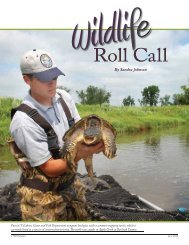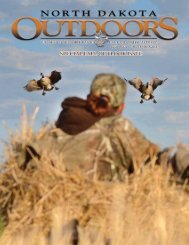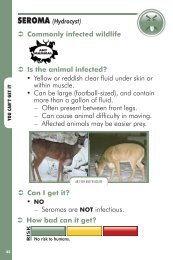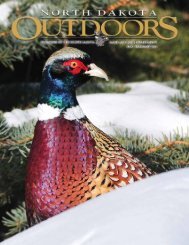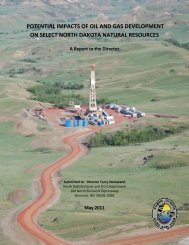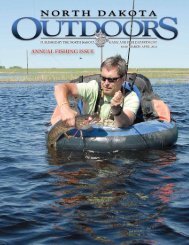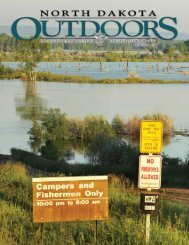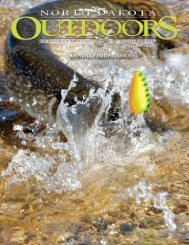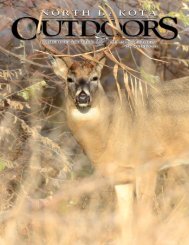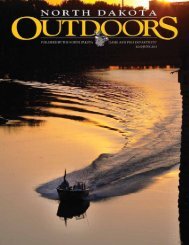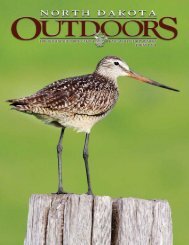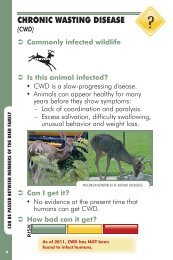March_April 2013.pdf - North Dakota Game and Fish
March_April 2013.pdf - North Dakota Game and Fish
March_April 2013.pdf - North Dakota Game and Fish
- No tags were found...
Create successful ePaper yourself
Turn your PDF publications into a flip-book with our unique Google optimized e-Paper software.
surveys continue to show that walleye<strong>and</strong> northern pike are very abundant,with about 75 percent of the adultwalleye between 10-15 inches long,<strong>and</strong> about 20 percent are between15-20 inches long. About one in 20walleye are 20 inches or longer. Thecurrent walleye size structure is on thesmall side, but should improve in thenext few years as the abundant youngerfish age <strong>and</strong> grow.<strong>North</strong>ern pike are running larger,with about 75 percent between 21-28inches <strong>and</strong> about 15 percent arebetween 28-34 inches.South <strong>Dakota</strong> State Universityis just completing a bioenergeticsstudy on Devils Lake. R<strong>and</strong>y Hiltner,Department fisheries supervisor inDevils Lake, has helped guide thisstudy to determine not only food habits,but also growth <strong>and</strong> mortality rates.Nothing too earth shattering in termsof what the predator fish eat. Scuds(freshwater shrimp), various otheraquatic insects, leeches <strong>and</strong> small fish,such as fathead minnows, are commontable fare. One finding of interest fromthe study showed that adult white bassdo not eat many small yellow perch.Regarding walleye reproduction, ithas been good for some time. Highlake levels provide good spawninghabitat as “new” shoreline is scouredby wave action <strong>and</strong> exposes clean rock<strong>and</strong> gravel.Q: Any thoughts on where the next, ifany, state record walleye might comefrom?A: Obviously the big three – Sakakawea,Oahe/Missouri River <strong>and</strong> DevilsLake – come quickly to mind. DevilsLake put out some very large walleyelast year, some of the largest ever outof that lake. However, sleepers for apossible state record include many ofour midsize reservoirs such as Darling,Audubon, Heart Butte <strong>and</strong> Ashtabula.And believe it or not, the Red Riverhas the ability to produce large walleye.Q: You work with fish all the time. Whatis your personal favorite type of fishing?Surveys on Devils Lake continueto show that about 75 percent ofthe adult walleye are between10-15 inches, <strong>and</strong> about one in20 are 20 inches or longer.A: Perch in the winter <strong>and</strong> walleye duringthe open-water season leads my list,but with a caveat. The only fishing Iwill do is where the crowds are not, soI pass up some hot bites. There’s nothingbetter than casting cranks fromshore at night or working the electricmotor on the Missouri pursuingwalleye in peace <strong>and</strong> quiet. It’s not justabout catching fish, but all the neatthings you see or hear while fishing inthe back 40. You may have to get upearly or stay out late, but thankfully<strong>North</strong> <strong>Dakota</strong> still offers quality fishingwithout the crowds.Q: Any creel surveys coming up thisyear?A: If all goes according to plan, there willbe a creel survey on Devils Lake thissummer <strong>and</strong> again next winter.Q: <strong>Game</strong> <strong>and</strong> <strong>Fish</strong> conducts populationsurveys on most of the perchlakes each year. Is there a place whereanglers can find out the results ofthose tests to eliminate wasted time<strong>and</strong> zero in on big perch lakes <strong>and</strong>avoid lakes with stunted perch?A: Though this may be a simple question,trying to answer it is anythingbut. However, the Department has notbeen, nor plans to be a repository of“where are the fish biting.” We continueto direct the public to the localbait shops, as they often have the latestfirst-h<strong>and</strong> fishing reports. In terms ofavailable information, we do currentlyprovide, <strong>and</strong> periodically update, directionsto a given lake, what species arecommon, <strong>and</strong> if available, a contourmap. This information is included inthe <strong>North</strong> <strong>Dakota</strong> OUTDOORS magazine<strong>and</strong> online at http://gf.nd.gov/fishing/fishing-waters.However, we haven’t provided catchrecord information. This matter hasbeen both a practical <strong>and</strong> philosophicaldebate for years with pros <strong>and</strong> conson both sides. The reality is that of thecurrent 400 water bodies in the statethat we’re actively managing, we areonly able to get to slightly more thanhalf of them during the course of theyear to assess the adult fish population.And for the water bodies we doget to, the catches can vary based on anumber of factors <strong>and</strong> so interpretationof catch records often require a broaderworking knowledge.For example, a high catch rate froma given lake does not necessarily translateinto angler success. Saying all that,we are providing additional informationabout our lakes in this magazine.(See Page 6). This is not catch recorddata, but summaries from the respectivefisheries supervisors for anglers touse <strong>and</strong> frame realistic expectations.This information will be updatedperiodically online at http://gf.nd.gov/fishing/fishing-waters.34 ND Outdoors <strong>March</strong>-<strong>April</strong> 2013SANDRA JOHNSON



